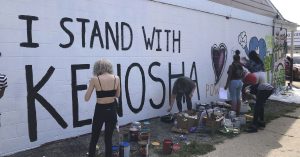The latest
COVID-19 and crime drastically transforming downtown Chicago
Managers of downtown office buildings report their properties have about 5% to 10% of their population on a typical workday. They expect a little more activity after Labor Day, but how much could depend on school situations.
“There are days I see more boat traffic on the river than cars on the streets,” said Lance Knez, vice president of Hines Interests and president of the Building Owners and Managers Association of Chicago, which has worked closely with the city to make sure health guidelines are followed and properties are ready for more people.
For Knez, the bottom line is this, “For people to come back to work, employers and employees must first feel safe.” That applies both to office cleaning regimens and to what’s going on outside.
Vicki Noonan, managing principal at Cushman & Wakefield, said she hopes more tenants will populate buildings after Labor Day, at least gradually. Some employers have talked about putting people on an alternate-day schedule for working from home, she said.
A June survey by the real estate firm CBRE of its national, big-company client base addressed the changing character of work. In it, 61% of 126 senior-level executives said all employees will be able to work outside the office at least part time. It also found only 10% of companies are considering leaving high-density urban cores, although satellite offices or flexible space deals may figure more prominently.
So don’t expect downtown or other business centers to roar back to life soon. The implications for Chicago’s commercial health and for our feelings about living here are enormous. The problems of the pandemic and violence are woven in the public mind.
Read the full column from David Roeder here.
News
7:51 a.m. State and local officials make accommodations to ensure voters are safe
The coronavirus has upended everyday life in ways big and small. What happens when those disruptions overlap with voting? Thousands of state and local election officials across the U.S are sharing ideas and making accommodations to try to ensure that voters and polling places are safe amid an unprecedented pandemic.
Some are finding ways to expand access to voter registration and ballot request forms. Others are testing new products, installing special equipment or scouting outdoor voting locations.
Here are virus-related obstacles voters could face during this unprecedented presidential election year along with some of the solutions being tried:
Check out voting obstacles and solutions here.
New Cases
Analysis & Commentary
8:11 a.m. Pritzker did not handle Metro East pandemic mitigation well
When Gov. J.B. Pritzker announced the state COVID-19 “mitigation” plan for the Metro East on Aug. 16, he said it was done in conjunction “with local officials in the Metro East region and across the border in St. Louis.”
Last week, though, the governor admitted the cross-border arrangement to try to contain the virus’ spread was a “mistake.”
Man, was it ever.
Instead of sticking to the state’s original mitigation plan, which would’ve included things like reducing indoor restaurant capacity and shutting down all indoor bar service, Pritzker only ordered bars and restaurants to close at 11 p.m., which was in line with what St. Louis was planning at the time.



















